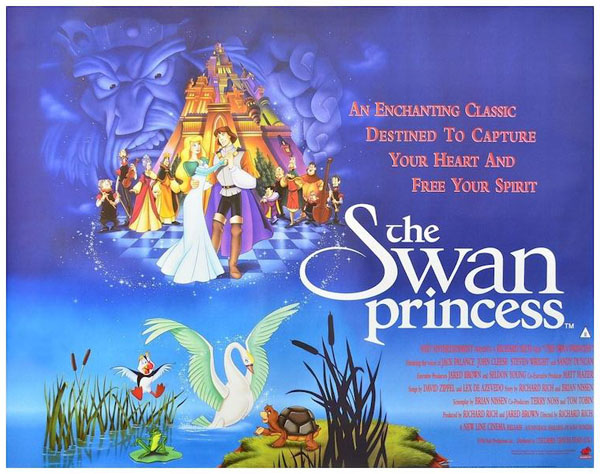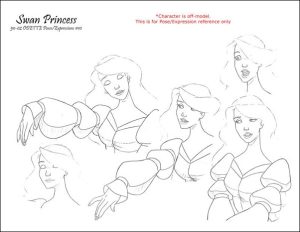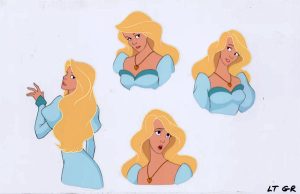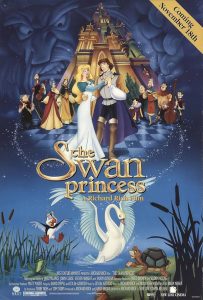



“We’re not so much competing with Disney, as we are competing with audience expectation,” said director Richard Rich in a 1995 interview, just after his film The Swan Princess had opened in theaters. He also added, “I think it’s wrong for one studio to have a monopoly on animation. I think as more and more studios get into the marketplace and the public learns that it’s not only Disney that can do it, it will make it easier for all of us to compete in that marketplace. It will take a little bit of time to break down that barrier that ‘only Disney can do it’. That’s what I was up against for years.” He also added, “I don’t think you can oversaturate animation. If it’s a good movie, people will go to see it, and it won’t matter if it’s animated or live action.”
 When The Swan Princess debuted thirty years ago, other studios and artists were throwing their hats into the animation ring, vying for some of the box-office and popularity that Disney was experiencing during their Renaissance era that had begun in 1989 with The Little Mermaid.
When The Swan Princess debuted thirty years ago, other studios and artists were throwing their hats into the animation ring, vying for some of the box-office and popularity that Disney was experiencing during their Renaissance era that had begun in 1989 with The Little Mermaid.
One of these was Rich Animation Studios, founded by Richard Rich, who began his career at the Disney Studio, where he co-directed such films as The Fox and the Hound (1981) and The Black Cauldron (1985).
Initially, Rich Studio’s first projects were a series of videos that were animated adaptations of historical legends and stories from the Bible. When Rich Animation Studio was acquired by Nest Entertainment in 1993, they were able to make their first full-length animated feature, The Swan Princess.
 Based on the ballet Swan Lake, the film centered on a young Princess named Odette, who is transformed into a swan by the evil enchanter, Rothbart who wants to take over the kingdom. Odette is ultimately saved by her true love, Prince Derek.
Based on the ballet Swan Lake, the film centered on a young Princess named Odette, who is transformed into a swan by the evil enchanter, Rothbart who wants to take over the kingdom. Odette is ultimately saved by her true love, Prince Derek.
The Swan Princess also featured three comedic sidekicks – Jean-Bob, a frog who thinks he’s a prince, a gruff bird named Puffin, and Speed, a laid-back turtle.
Recalling how the sidekicks came about in that 1995 interview, Rich remembered, “We made the decision early on that the first thing we would do is eliminate all the ballerinas because it’s just too complicated. Then, I said, ‘What would you see in a lake?’ and I had this image of a frog sitting on the back of a turtle.”
The voices of the sidekicks were John Cleese as Jean-Bob, Steve Vinovich as Puffin, and Steven Wright as Speed. The combination of the vocal performances with the character animation made for some entertaining and memorable personalities.
 The Swan Princess also featured the talents of Michelle Nicastro as Princess Odette, Howard McGillin as Prince Derek, Sandy Duncan as Queen Uberta, and Jack Palance as the villain, Sir Rothbart.
The Swan Princess also featured the talents of Michelle Nicastro as Princess Odette, Howard McGillin as Prince Derek, Sandy Duncan as Queen Uberta, and Jack Palance as the villain, Sir Rothbart.
“We videotaped all of his recording sessions, and then we printed out all of [Jack Palance’s] expressions,” said Rich in 1995. “We had this board that had all these different expressions on it that the animators could use. I mean, he is so animated!”
The animators also incorporated Palance’s iconic Oscar Awards show moment from 1992, when he did one-armed pushups during his acceptance speech for Best Supporting Actor in City Slickers. The character does the same in Rothbart’s big musical number in The Swan Princess.
“It’s interesting,” noted Rich in 1995, “for the people who saw the Academy Awards two years ago, that gets a huge laugh. If they don’t know much about Jack Palance, then it’s just a funny thing having a villain do a one-armed push up. It works either way, but boy, for an inside joke, that really was a huge laugh.”
Rothbart’s song, “No More Mr. Nice Guy,” was just one of the film’s songs crafted by Lex de Azevedo and lyricist David Zippel (who would go on to write the songs for Disney’s Hercules). The singing voices in the film included Liz Callaway as Odette, Adam Wylie as Derek, Jonathan Hadary as Speed, with de Azevedo as Rothbart and Zippel as Jean-Bob.
 There was also the ballad “Far Longer Than Forever,” which received a Golden Globe nomination.
There was also the ballad “Far Longer Than Forever,” which received a Golden Globe nomination.
Released on November 18th, 1994, The Swan Princess didn’t fare well at the box office and was outgrossed by The Lion King, which Disney re-issued to theaters that November after its blockbuster performance during the summer of ’94.
“The one big thing that we have going is that animation is really big in video sales,” said Rich. “Most families will buy [videos] for their libraries at home, while a lot of the live-action stuff they won’t.”
It’s prophetic that Rich said this the year after The Swan Princess was released, as the film went on to have renewed life on home video. Not only did it perform well on VHS when it was released, it has inspired no less than eleven direct-to-video sequels.
Reflecting on this success months after the theatrical debut of The Swan Princess, Rich commented on the film’s universal message: “We should love each other the way that Derek and Odette did, and when you do, there’s no obstacle you can’t really overcome. Stick with your convictions. I mean, Derek was the only person who believed that Odette was alive. We can make our minds up and when those convictions and commitments are good and wholesome, then stick with them and follow them all the way through. I think that’s what the picture teaches us.”